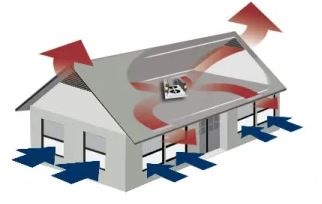Most people are familiar with the abbreviation “H-V-A-C,” but most do not really think about what it mean. Basically, the abbreviation quite literally stands for “Heating, Ventilation, and Air Conditioning.” For the most part, people easily grasp the concepts of heating and cooling the indoor environment. That settles the “H” and the “AC,” but what about that “V” in between? Among the people who know that the “V” stands for “ventilation,” how many of them know what “ventilation” really is?
It is likely the most misunderstood element of the abbreviation itself. A well-ventilated home means better indoor air quality. But ventilating does not simply mean opening up your windows on a beautiful day. It encompasses a wide range of actions you can take to ensure that the air coming into your home is free from irritants, contaminants, and pollutants—and that it remains clean. When your home is well-ventilated every day, your family stays healthier, sleeps better, feels better and has more energy.
What Is Ventilation?
Most homeowners equate ventilation with opening a window or door and letting the fresh air in. Of course, in Southern California, that is not always possible during the summer season when temperatures routinely soar into the 100s and above. In terms of properly installed HVAC, ventilation is the movement and circulation of air in, throughout and ultimately exiting your home. The goal is to constantly refresh the air inside your home. This helps to eliminate problems associated with stagnation, removes odors, fumes and VOCs and reduces unhealthy levels of humidity.
Why Ventilate?
For centuries homes were not ventilated. So why are we doing it now? Well, there are several reasons that ventilation is more important today than it was long ago. Most importantly, houses 100 years ago typically did not have insulation in the walls, so fresh air could pretty easily enter through all the gaps, cracks, and holes in the structure.
Also, the building materials used 100 years ago were mostly natural products that did not result in significant off-gassing of volatile organic compounds (VOCs), formaldehyde, flame retardants, and other chemicals that are so prevalent in today’s building materials, furnishings, and other household products.
Poor Ventilation
When one or more of your ventilation processes fails, indoor air quality can deteriorate. Proper design, operation, and maintenance of the ventilation system are vital to providing indoor air that is free of harmful pollutants.
Since HVAC systems can also contribute to problems with indoor air quality, it is important that HVAC systems be correctly maintained and checked for signs of poor ventilation. When systems go unchecked for long periods of time, they may become contaminated or clogged, reducing or eliminating the amount of airflow and circulating pollutants throughout your home.
Humidity and Ventilation
Imagine a bathroom with no working windows and a broken exhaust fan. Within a few minutes of turning on the shower, there is steam on the mirror and water droplets collecting on the ceiling, walls and tiles. Without exhaust or ventilation, the humidity builds, the temperature rises, and the bathroom becomes extremely uncomfortable. Within a few days or weeks, the increased humidity can lead to the growth of mold on the walls and tiles, which can be hazardous to your health. If you have visible mold anywhere in your home that generally indicates the indoor relative humidity is too high, and your home could benefit from improved ventilation.
What Can Be Done for Better Ventilation?
There are a few basic steps you can take to make sure you have air circulating properly around your house.
- Properly seal areas in the house where water could enter such as the basement, door, windows, and showers.
- Seal and insulate gaps to prevent air from getting in non-conditioned areas including the basement, attic, wall and crawl space.
- Keep the doors and windows open during and after showering, cooking and other moisture-producing indoor activities.
- Invest in a dehumidifier if you are having trouble controlling moisture at home.
Consider a Home Ventilation System
A well-designed and well-installed home ventilation system provides great ventilation regardless of what the weather is like outside, which is a great alternative to simply opening doors and windows. If you don’t have one already, a home ventilation system can replace stale air in your home with fresh, dry air to create a healthier, drier and warmer living environment for your family that is much easier to heat.
Call Us Today!
If you want better fresh air ventilation in your home, we can help with the installation of an energy recovery ventilator or heat recovery ventilator. These devices work in a similar fashion: they pull fresh air from outdoors into the HVAC system, then use indoor air to pre-heat or pre-cool it. Your home receives air that’s already close to the temperature you want while expelling dusty and stale air outside. It’s like opening your windows, but without letting the heat or cold enter along with the fresh air.
If your system needs repair or inspection before winter, call Aire-Tech on 951-926-1002. You can also visit our Contact page and complete the contact form.

